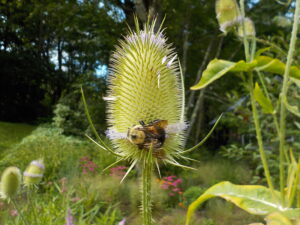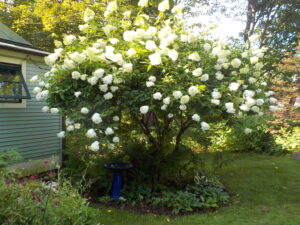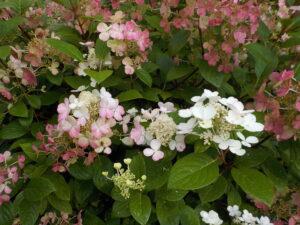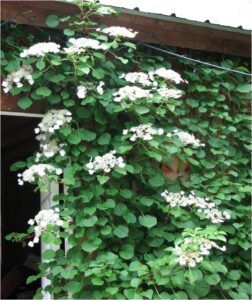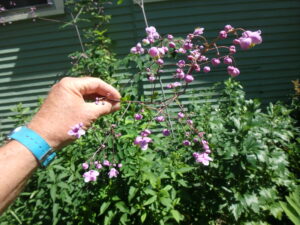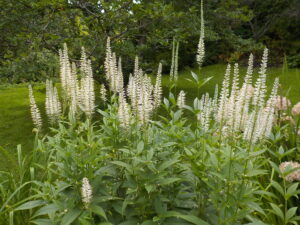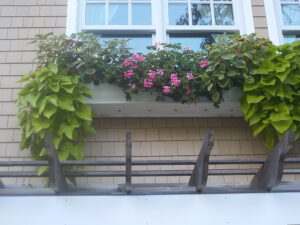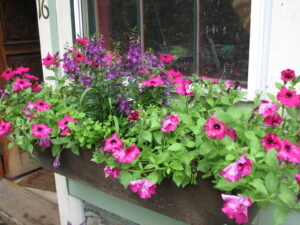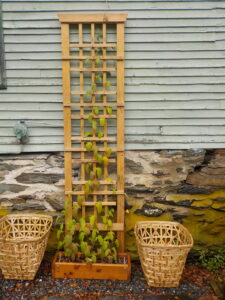Cooking and Gardening: A Marriage Made in Heaven
Posted on Tuesday, August 29, 2023 · Leave a Comment
I love to cook, and I love to eat. I got started gardening in the vegetable garden more than 70 years ago, in part, because everyone I knew loved to eat homegrown vegetables – raw in the garden, fresh in the kitchen, or cooked for dinner. I’d pull a carrot and rinse it off with a hose – or just wipe off the dirt on my shirt. My mother didn’t care if I ate some fresh (organic) soil with my carrot, she was just glad I liked carrots.
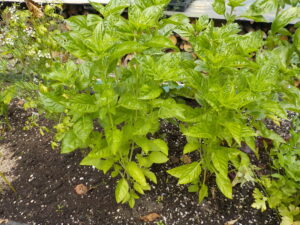
Pick basil before it flowers if possible
This is the season for pesto, a dish that is heavenly – and simple to make. It has just 4 basic ingredients: fresh basil, garlic, Romano or Parmesan cheese, olive oil and nuts (and salt and pepper to taste). I used to use pine nuts, but when their price went north of $20 a pound I switched to walnuts. They taste great, too.
We grow a lot of basil each year – 20 plants or more this year. You can grow it in big pots if you don’t have space for a vegetable garden. But this year, if you didn’t grow basil, visit your local farm stand and get a couple of big bunches. For my recipe you will need 2 cups of basil leaves packed down in a 2-cup measure.
If you grew your own basil, hopefully it has not started to bolt – get tall and flower. It will still be useable even if it has, but it is tastier before that happens. Throw away any flowers that have appeared – and snip off flowers on other plants that you are not harvesting today. Blossoming makes the basil a bit bitter.
Wash the basil, then spin dry in a salad spinner if you have one. Remove the leaves from the stems and then pat the leaves dry with a cloth towel. You need enough basil to fill a 2 cup measuring cup with leaves packed down firmly, which is a lot of leaves.
Place leaves in a food processor and add 1/3 to ½ cup of roasted walnuts or pine nuts and pulse a few times. I brown the raw nuts in a cast iron fry pan at medium heat. They brown better if you lightly oil the pan. But be careful, they can easily be burned, so stay right there, stirring constantly until they just brown. I find roasting improves the flavor considerably.
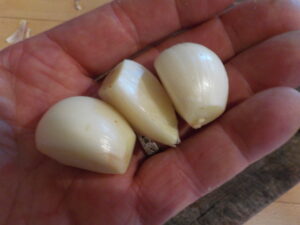
I used these 3 cloves in one batch of pesto
Next prepare the garlic. You can use a lot or a little, depending on your love of raw garlic. I crush 3 large or 6 small cloves of garlic in a garlic press, add to the blender and pulse. I grow my own garlic but you can buy it if you don’t. Hard neck garlic is more flavorful than soft neck – ask for it at a farm stand, as grocery stores don’t tend to sell it.
Add a third to a half a cup of olive oil slowly with the food processor running. Blend the ingredients until the leaves, nuts and garlic are totally blended. Finally add half a cup of grated Parmesan or Romano cheese and pulse until well mixed in. Taste immediately on a toasted baguette or an English muffin. This is heaven.
This has not been a stellar year for tomatoes. All the rain and the paucity of sun has caused many tomatoes to get overwhelmed by fungal diseases. Fortunately, one of my favorites has done well. It’s called Sun Gold. It’s a cherry tomato that is not only delicious, it is relatively productive and disease resistant. I grow a dozen plants each year and each plant gives me a 100 tomatoes or more. They grow in clusters of 10-to-20, producing from early to late in the season.
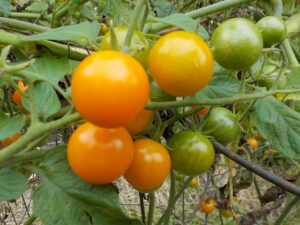
‘Sun Gold’ cherry tomatoes are one of my favorites
I dehydrate most of my Sun Golds, but also love them fresh in salads, sandwiches, or cut in half and mixed with pesto. When I put them in a food dryer, I cut them in half with the cut side up. They turn into little nuggets of summer I use all winter in soups and stews.
Pesto is also good with boiled homegrown potatoes. I serve it as a potato salad with fresh tomatoes and a little celery. Yes, after giving up on celery years ago, I grew it this year and it has done well with all the rain. Although in the past it was tough, stringy and attracted slugs, this year it has been a pleasure to grow. I don’t harvest it all at once, but go down to the garden and cut what I need for that day. The stems are much smaller than commercial celery, but I’m glad I grew it.
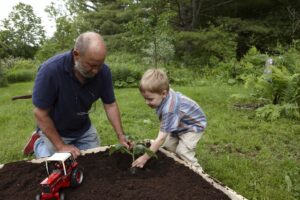
Get your grandkids involved in the garden
I think the world would be a better place if every child learned to garden -and learned the joy of eating fresh vegetables. You can teach your kids or grandchildren to love gardening the way my family did: welcome kids to the garden, offer them meaningful jobs that are easy and fun, and never leave them alone to pull weeds. Let little ones ride in a wheelbarrow on top of a pile of weeds you pulled.
One of my first jobs in the garden was to stir the “tea” my Grampy brewed in a wooden barrel full of rain water and hen manure. I stood on an apple crate and stirred it with a long stick. It was a messy job, and a bit stinky, but it seemed like real work to a three-year old. Eventually I was allowed to dip out the tea in a metal frozen orange juice can, and give each tomato plant one full can. I’ve been hooked on gardening ever since.
Gardening really should be for everyone, so get your little people to spend time with you in the garden, even if they only search for toads and bugs or push trucks around.
Henry is a lifetime organic
gardener living in Cornish, NH. He presents at
garden clubs and libraries around the region, and is the author of 4
gardening books. Reach him at
henry.homeyer@comcast.net.
How to Reduce Your Time Weeding
Posted on Thursday, August 24, 2023 · Leave a Comment
The recent rains have kept many gardeners from getting outdoors to weed, and weeds have loved the rain and are growing like Boy Scouts on “Free Ice Cream Day” at the Ben and Jerry’s factory. But don’t give up. Weeds also pull well now, with the soft, moist or soggy soil, so get to work!
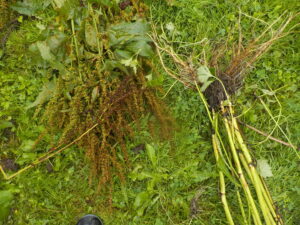
Seeds and roots of dock, a big weed
Recently I spent an hour or so pulling dock (Rumex spp.), a coarse, tall weed that can get to be five-feet tall or more. There are several species of dock, but all are about the same. And all have deep, fleshy roots that often fork and divide deep in the ground.
I took a garden fork and plunged it into the soil a few inches from each clump of weeds and tipped back he handle to loosen the soil. For the biggest clumps I used the fork in up to four places – once on each side. Then I grasped the clump of strong stems down low and leaned back, allowing all my weight to slowly pull out the weed. And out they came, roots and all. Very satisfying. If I tried that when the soil was dry, it would have been much more difficult and resulted in broken roots which would re-sprout the pesky weeds.
I worked on those dock plants now as they had already flowered and had formed seeds – which I don’t want in the soil. If pressed for time, I could have just cut the plants at ground level so the seeds would not be dispersed, but I favored pulling the weeds and getting rid of them once and for all.
Herbalists use dock for various concoctions, not the least of which, I have read, is to prevent “elf sickness”. Not much of that around here, but if you have a problem with it, consult “Just Weeds: History, Myths and Uses” by Pamela Jones (Chapters Publishing, 1994). It’s an interesting and amusing read.
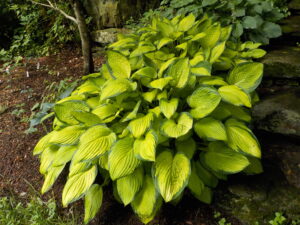
Weeds can’t compete with these big hosta plants
I’ve been working on most of my flower gardens for at least 40 years and have lots of mature plants. This allows me to brag that in some beds I need not weed at all – or only very occasionally. How is that? The plants are growing so close together that most weeds cannot compete. The weeds are shaded out – or starved for nutrients and moisture by plants with deep roots and thick leaves.
One of those plants good for outcompeting weeds is the ever-present shade lover, hosta. Although I sometimes plant daffodils between hostas, the daffies bloom and the foliage dies back by the time hostas are fully leafed-out. Most common weeds will not compete well with hostas.
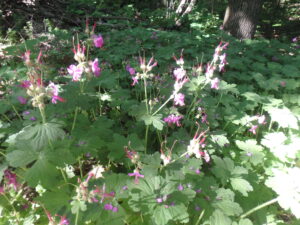
Bigroot geranium makes a nice groundcover that out competes most weeds
Bigroot geranium (Geranium macrorrhizum) is another plant that outcompetes weeds. I use it as a groundcover – the leaves stand 12-inches tall or more, and it blooms with pink, magenta or white flowers in early summer. It works well in dry shade, but will grow in sun or shade. It spreads by root, so plant three plants a foot apart in a triangle and let them fill in the space. Once well-established, it outcompetes most anything.
What else? Sweet Woodruff (Galium odoratum) is good for sun or shade and once established, spreads well. It stands about 8 inches tall, and has fragrant white flowers in the spring. It may be a bit too aggressive, though. It can run roughshod over more delicate plants, growing right up to them and stealing moisture and nutrients. This year I plan to weed some out of a dry shade bed where it is diminishing the effectiveness of some primroses.
Dead nettles (Lamium spp.) is another shade to part-shade ground cover and like the plants above, is non-native here in the United States. It is low-growing with green and silver or white leaves and attractive small flowers that can be pink, white or even yellow, depending on the species. Rarely do I see grasses or weeds coming through plantings of it.
As to full-sun plants there are many that, once established outcompete weeds. Among those are Amsonia, astillbe, black-eyed Susans, daylilies, daises, European wild ginger, Siberian iris, Helenium, phlox, iris, and goldenrod. But even these take time to establish themselves. Not only that, you need three or more of each in a planting, and patience.
A perennial plant that will form a clump two or three feet wide when mature will come in an 8-inch pot. For most plants, it will take three years – or more – to get to full size. If you plant them 18 inches apart, they will fill in and their leaves touch sooner than if you plant them farther apart. Think of dice with 3 or 5 dots. Those are good patterns for planting if you want overlap, much better than planting them in a row.
Weeds will grow almost anywhere, even in your gravel driveway. Cultivated plants need some help to get established. So when you plant, dig a wide hole, say two feet wide for an 8-inch potted plant. Put in two or more shovels of compost and stir it up, mixing the native soil with the compost. I always add some organic slow-release fertilizers to the hole, too. That first year water when dry.
Mulch helps young plantings to get established. They help keep weed seeds from germinating and hold in moisture. You will still have to weed for a few years while getting your flower bed to maturity.
There is no such thing as a weed-free garden. But with time and effort, you can reduce the work considerably once established.
Unlike the games of chance at our local fair, you always win when you buy a hydrangea. They generally bloom their fool heads off every year, even if you have poor soil and a poor track record in the garden. When I was a boy I noticed that every cemetery had hydrangeas, so I called them cemetery bushes (my parents knew few names of plants). Now is the time they are blooming so it is time to go to your local, family-owned garden center and buy one – or more than one.
If you want a tall plant with instant curb appeal, buy what is called a hydrangea “standard”. A standard is a shrub that has been grafted onto a tall stem, usually about 5-feet tall. Hydrangeas start out low and often wide, but if you get a standard, you get something that looks a bit like a lollipop – or an instant small tree.
I have six different hydrangeas, each differing in bloom time, color, size of blossom and shape of blossom. Two of mine are standards and are about 25 years old. Each is 15 to 20 feet tall and wide.
My PeeGee hydrangea has blossoms of various sizes, from 5 inches across to 8 inches or more across. Most blossoms are roughly globular, but some are a bit elongated, especially towards the top of the plant. The panicles are a mixture of fertile and showy, infertile florets. The blossoms start out a green-tinged white, transforming to white, then pinkish, and finally brown after frost. If you pick the blossoms before frost and put them in a dry vase, they will stay looking pinkish all winter and beyond.
I love my “Pink Diamond” hydrangea; it is also a H. paniculata grandiflora, and lives up to its name even better than a PeeGee. Its uppermost flower panicles can reach 12 inches long and 8 inches wide. The woody stems are thicker and stronger than on most hydrangeas, so they do not flop the way some others do when wet from rain. The pink panicles are a delight to behold.
There is one native hydrangea, called smooth hydrangea (Hydrangea arborescens). It stays small, only 3-to 6-feet tall and wide. It does well in partial shade, but is intolerant of dry soils. It will tolerate full sun only if the soil stays moist. ‘Annabelle’ is commonly sold in the nursery trade but I can’t imagine why. Yes, it does have huge panicles, but it has flimsy stems so the panicles droop or flop onto the ground.
According to the Mt. Cuba research station, the best hydrangea for pollinators is the smooth hydrangea called ‘Haas Halo’, a native one. I planted several for a client one fall and they were immediately consumed by deer. But they came back the following spring and I surrounded them with wire fencing to keep the deer away. In year three they are blooming nicely. The center of each flat flower head is full of small, fertile flowers surrounded by larger white flat, infertile florets.
Readers often write me asking how to get the numerous blue panicles in years two, three and beyond. I tell them to treat them as expensive annuals. Dig them up and throw them on the compost if they don’t succeed. Instead of Endless Summer, I call them Endless Disappointment. There are now other blue hydrangeas sold, and some may be okay for our climate.
So if you like the look of hydrangeas, go get one. I think most are wonderful.
